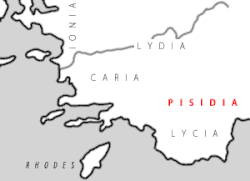Pisidia
This article needs additional citations for verification. (October 2019) |
| Pisidia (Πισιδία) | |
|---|---|
| Ancient Region of Anatolia | |
 |
Pisidia (.
Geography
Although Pisidia is close to the Mediterranean Sea, the warm climate of the south cannot pass the height of the Taurus Mountains. The climate is too dry for timberland, but crop plants grow in areas provided with water from the mountains, whose annual average rainfall is c. 1000 mm on the peaks and 500 mm on the slopes. This water feeds the plateau. The Pisidian cities, mostly founded on the slopes, benefited from this fertility. The irrigated soil is very suitable for growing fruit and for husbandry.
History
Early history
The area of Pisidia has been inhabited since the Paleolithic age, with some settlements known from historical times ranging in age from the eighth to third millennium BC.
Late Bronze and Iron Ages
The ancestors of the classical Pisidians were likely present in the region before the 14th century BC, when Hittite records refer to a mountain site of "Salawassa", identified with the later site of Sagalassos. At that time, Pisidia appears to have been part of the region the Hittites called Arzawa. The Pisidian language is poorly known, but is assumed to be a member of the Anatolian branch of Indo-European languages.
There is a
As far back as the Hittite period, Pisidia was host to independent communities not under the Hittite yoke. Known for its warlike factions, it remained largely independent of the
for greater control, were unable to cope with constant uprisings and turmoil.Hellenistic period
. The cities in Pisidia were among the last in western Anatolia to fully adopt Greek culture and to coin their own money.Pisidia officially passed from the Seleucids to the Attalids as a result of the

In 39 BC
Roman and Byzantine rule
After king
During the Roman period Pisidia was colonized with veterans of its legions to maintain control. For the colonists, who came from poorer parts of Italy, agriculture must have been the area's main attraction. Under Augustus, eight such colonies were established in Pisidia, and Antioch and Sagalassos became the most important cities. The province was gradually Latinised. Latin remained the formal language of the area until the end of the 3rd century.
Pisidia became an important
The area was devastated by an earthquake in 518, a plague around 541–543, and another earthquake and Arab raids in the middle of the 7th century. After the
Notable people
- George of Pisidia (7th century) - Byzantine poet
See also
References
- ^ The New Century Classical Handbook; Catherine Avery, editor; Appleton-Century-Crofts, New York, 1962, p. 896: "Pisidia...a territory in Asia Minor. It was bounded by Phrygia on the N, Isauria and Cilicia on the E, Pamphylia on the S, and Lucia on the SW"
- ^ Gonzales, Matthew (2005). "The Oracle and Cult of Ares in Asia Minor". Greek, Roman and Byzantine Studies. 45 (3): 262–263, n. 3 and esp. n. 5.
- ^ Acts 13:13–52 and 14:21–23
- ^ Acts 16:1
- ^ Acts 18:23
Further reading
- Bean, G. E. “Notes and Inscriptions from Pisidia. Part I.” Anatolian Studies, vol. 9, 1959, pp. 67–117. JSTOR, www.jstor.org/stable/3642333. Accessed 24 Apr. 2020.
External links
- Termessos on the Web, comprehensive guide to the striking Pisidian city
- Sagalassos on the Web, comprehensive guide to the striking Pisidian city
- Termessos Guide and Photo Album
- Sagalassos Guide and Photo Album
- Herbermann, Charles, ed. (1913). . Catholic Encyclopedia. New York: Robert Appleton Company.
- Ancient Sagalassos: Pride of Pisidia
- Beyaz Arif Akbas: "Sagalassos: City of Fairies", Adrianapolis, Yalnizgoz Yay. 2010,

